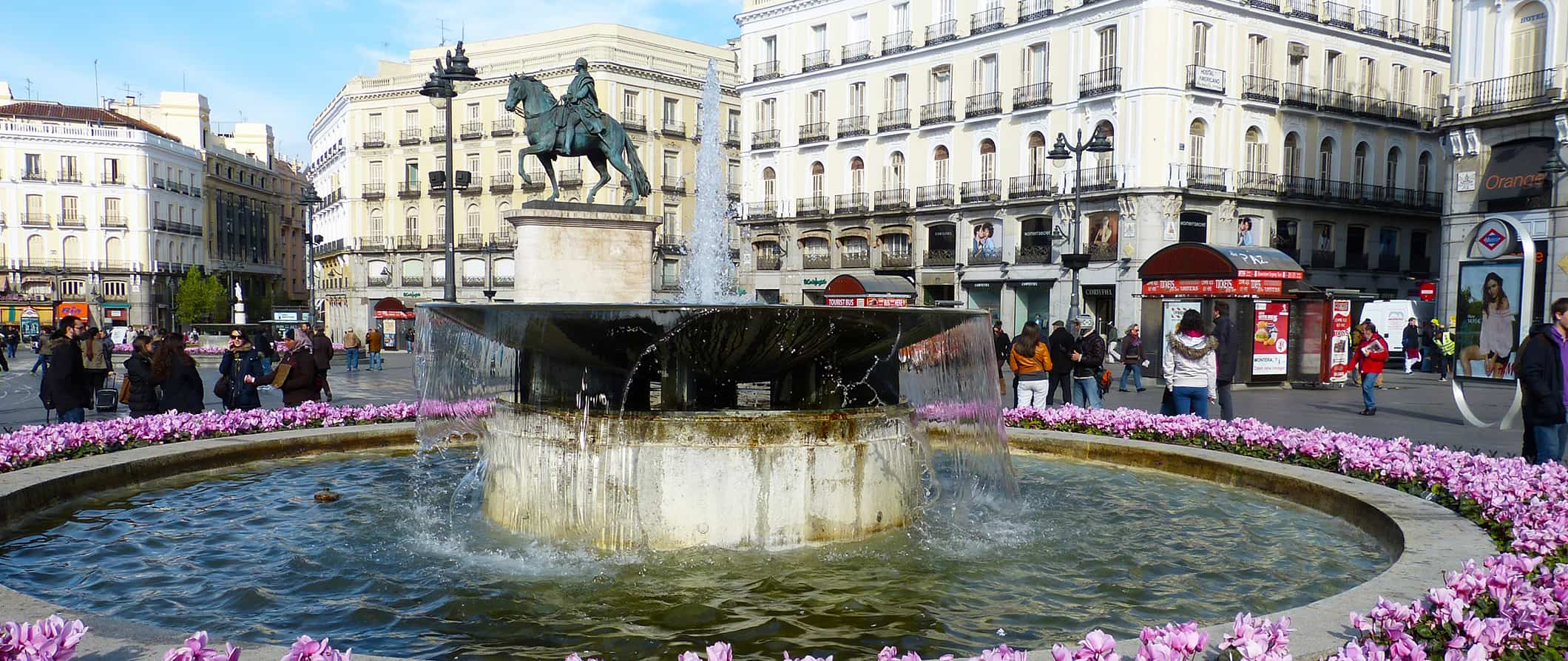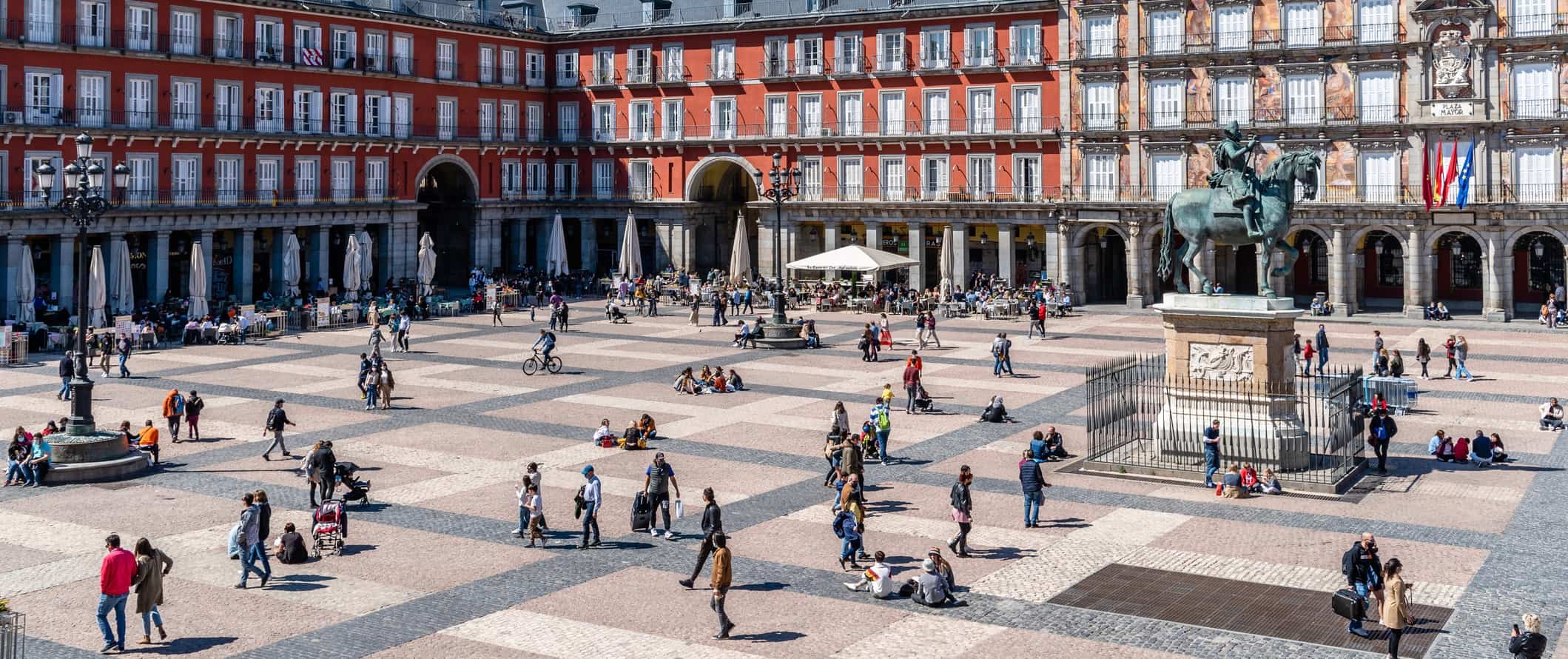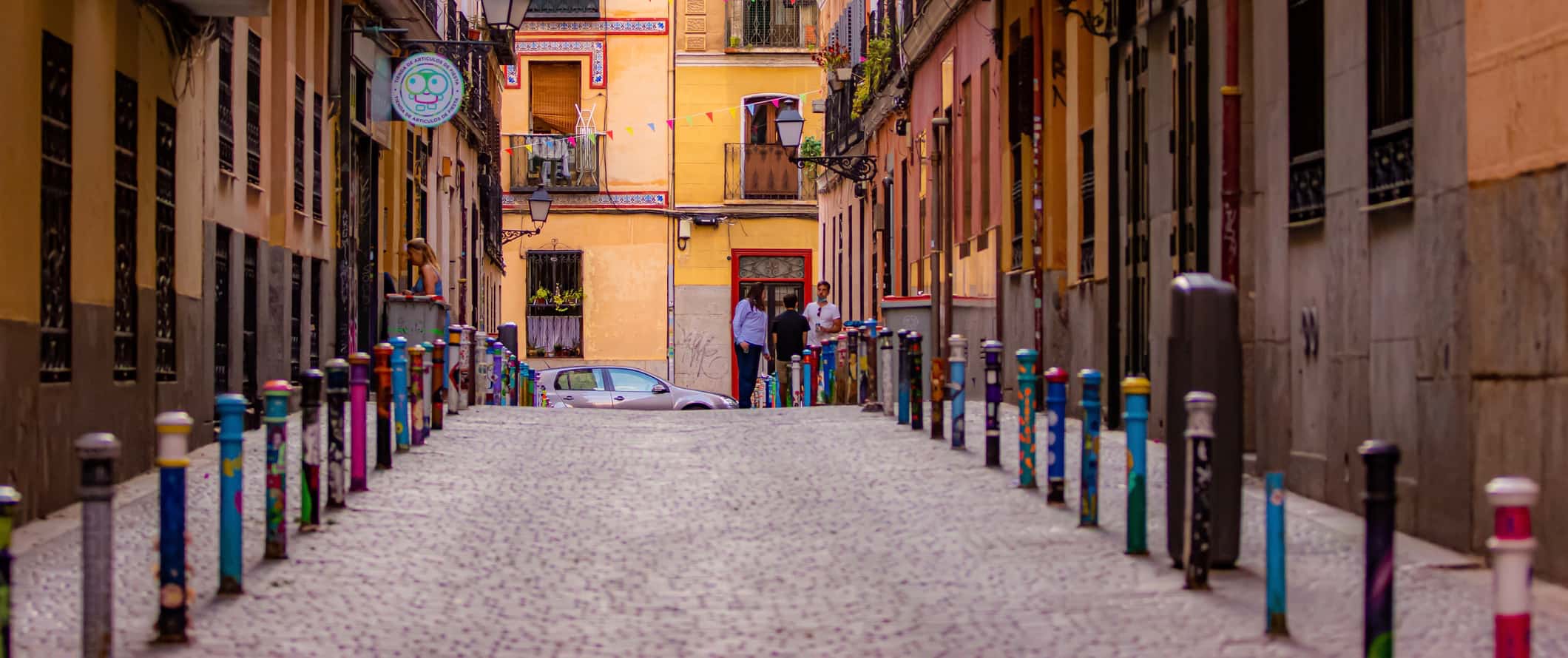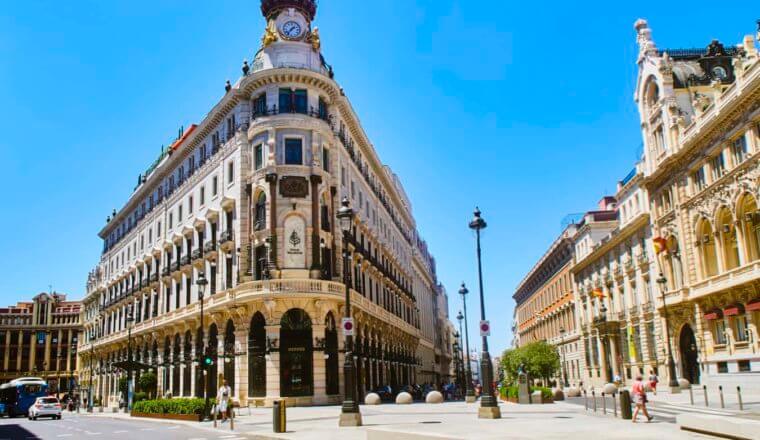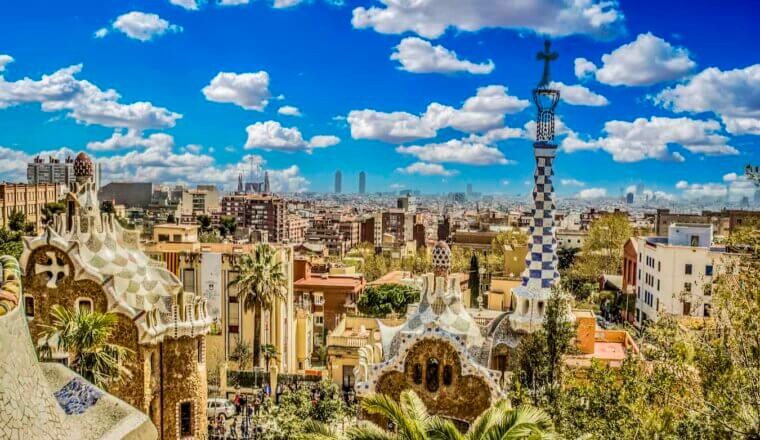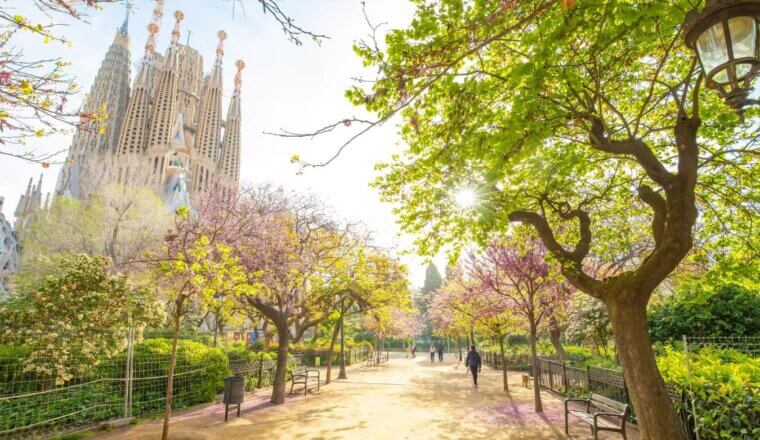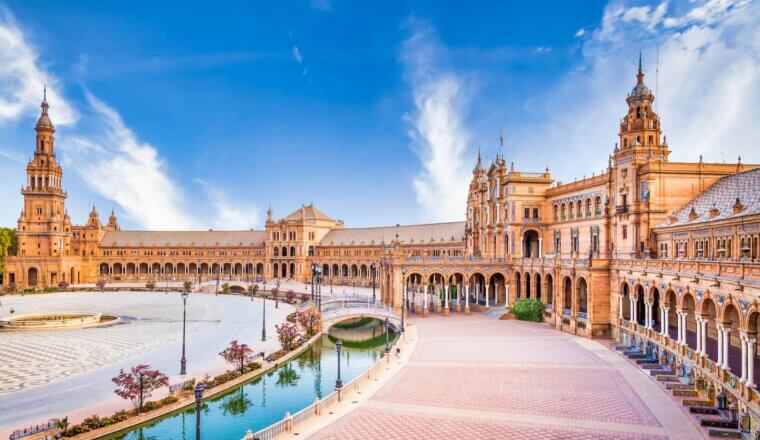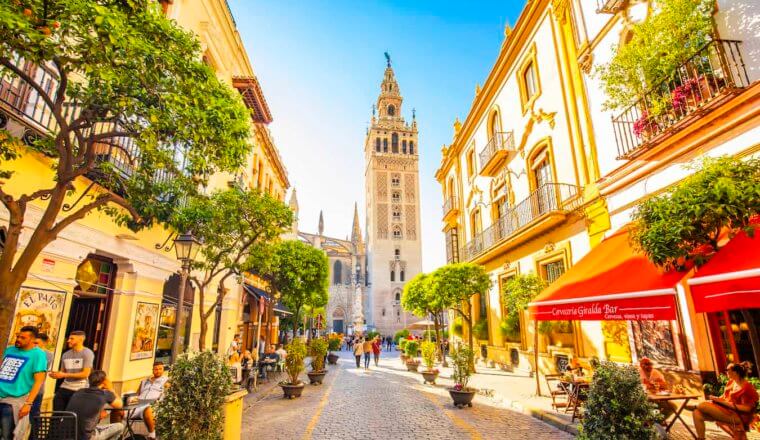Madrid is the capital of Spain and the country’s largest city. With energetic vibes, world-class food, incredible architecture, museums, and a nightlife that stretches until dawn, the city is one most visitors love.
Like its rival Barcelona, Madrid embraces the night. Dinner doesn’t happen until 9pm or 10pm and the partying doesn’t kick off until several hours after that. It’s a city for night owls.
Though it’s somewhat sprawling, Madrid’s numerous neighborhoods are perfect for getting lost in, binging on tapas, and drinking sangria. The warmth of the locals and the slowness of the meals will keep you out late as you soak in the city’s pace. If you embrace the late (and long) meals and the late-night partying and live your life on Madrid’s terms you’ll have a much deeper, enriching visit.
This Madrid travel guide will give you everything you need to know to eat well, save money, and see the best sights the city has to offer!
Table of Contents
Top 5 Things to See and Do in Madrid
1. Stroll Plaza Mayor
The Plaza Mayor, which dates to the 15th century, is Madrid’s main square. While walking this plaza, which was designated a Spanish Property of Cultural Interest in 1985, don’t miss Ayuntamiento (the impressive city council building), the Baroque Church of San Pedro, the 18th-century San Francisco el Grande Basilica, and Calle de Cuchilleros (a popular place to eat, but expect tourist prices). In summer, the plaza hosts various festivals and music events, and in winter, it’s home to a sprawling Christmas market.
2. Visit the Prado Museum
The Prado Museum (Museo Nacional del Prado) is one of the world’s greatest art galleries and the largest art museum in Spain. It’s also one of the most-visited museums in the world and has earned that title because it’s a great destination even for those who aren’t “museum” people. See a dazzling display of around 20,000 works by the great European masters housed in a grand 18th-century building that opened as a museum in 1819. The museum is also a UNESCO World Heritage Site and a Spanish Property of Cultural Interest, home to works by Goya, Rembrandt, Caravaggio, Bernini, Monet, and many others. Admission is 15 EUR, and it takes about 3 – 4 hours to see the highlights of the museum.
3. Unwind in El Retiro Park
Officially known as The Buen Retiro Park, this is the main park of Madrid. It’s a leafy oasis with more than 15,000 trees and a UNESCO World Heritage Site, making it the perfect place to relax on a sunny day. The park dates back to the 17th century and spans over 350 acres. There is a large lake where you can hire a rowboat, a monument to the victims of the Madrid terrorist bombings (which killed 193 people and injured over 2,000 in 2004), and the Crystal Palace (a 19th-century conservatory that once held a human zoo).
4. Visit the Palacio Real
While the King of Spain no longer lives in the palace, it is used for state ceremonies. Built in the 18th century, the Baroque-style palace is the largest functioning palace in Europe, home to over 3,400 lavishly decorated rooms. The palace was originally built on a former 9th-century Muslim fort and today functions much like an art museum with numerous works, including pieces by Caravaggio, Juan de Flandes, and Francisco Goya. Admission is 14 EUR for self-guided tours and 20 EUR for a guided tour. Audio guides are available for 5 EUR. It’s free for EU citizens on Wednesdays.
5. Take a food tour
To learn more about the history and culture behind Madrid’s cuisine, take a food tour. It’s the best way to eat your way around the city, sampling the best eats Madrid has to offer, from tapas and cured meats to churros with chocolate while learning what makes the cuisine unique. Devour Tours runs in-depth food tours led by expert local guides that will introduce you to the food culture and its history. If you’re a foodie like me who wants to learn more about the history and culture behind each dish, this tour is for you! Tours start at 89 EUR.
&nsbp;
Other Things to See and Do in Madrid
1. Take a free walking tour
Free walking tours are one of my favorite activities to do in a new city. You’ll get the lay of the land, learn about the history and culture, and connect with a local guide who can answer all your questions. New Europe, Free Walking Tours Madrid, and Cat’s Hostel Walking Tours are the best free tours in the city. Just remember to tip your guide at the end!
2. Check out Puerta del Sol
This is Madrid’s most famous and central square. Originally, it was the site of one of the east-facing city gates and was adorned with an image of the sun, hence the square’s name (“The Sun Gate”). The square is actually semi-circular in shape and owes its current form to the major renovation work carried out between 1854-60. There’s a stone slab on the ground in front of Casa de Correos’ main entrance (the current headquarters of the Madrid regional government) to mark kilometer 0, as this is also the center of Spain’s radial road network. The area has plenty of bars, restaurants, and shops, and makes for an easy central location to meet up with friends. People congregate here on New Year’s Eve to celebrate under the clock on top of the Casa de Correos building. It’s tradition to eat a “lucky” grape for each of the 12 strokes of midnight.
3. See flamenco dancers
The highly emotive dance set to guitars and singing originated in Andalusia and migrated to Madrid by the early 19th century. Based on the various folkloric music traditions of southern Spain, the shows will leave you transfixed. You’ll find flamenco shows in many bars and taverns across the city, such as Las Carboneras where you can enjoy a flamenco show with a glass of wine for 45 EUR. The historic Corral de la Morería offers shows for 49.95 EUR, including a drink.
4. Visit the National Archaeological Museum
This museum is a must for those who love ancient artwork and archeological finds. You’ll find an incredible collection of everything from ancient statues to ornate gold chandeliers from across the Iberian Peninsula. There are items from ancient Greece and Rome, along with artifacts from the Visigoths, Egypt, and Mesopotamia. Don’t miss the famous La Dama de Elche (a near-perfect condition bust of a 5th-century Iberian woman) and the Altamira pre-historic cave paintings. You’ll also see the Guanche Mummy of Madrid. He was embalmed by the indigenous people of the Canary Islands between the 11th and 13th centuries. Admission is 3 EUR.
5. Explore the Naval Museum of Madrid
When you think back on the world’s historical naval powers, the 16th-century Spanish Armada likely comes to mind. You can come here to learn about the nation’s rich naval history through historic maps from as early as the year 1500. It also has lots of old drawings, weapons, and navigation equipment, and a really interesting and detailed section on the Spanish Armada. It’s located on Madrid’s Art Walk near the Prado Museum and makes a nice stop in between the larger, more crowded galleries (most people skip this one). Admission is free, but donations of 3 EUR per person are suggested. It’s closed on Mondays.
6. Admire some modern art
The Museo Nacional Centro de Arte Reina Sofía (Reina Sofía National Art Center) offers a fantastic collection of modern art. Works by masters like Picasso, Miró, Kandinsky, Dalí, and Bacon can all be found here. The centerpiece of the exhibit is Picasso’s famous Guernica painting, a 1937 oil painting that’s considered the most moving anti-war painting in the world. While I don’t love modern art, even I enjoyed this museum more than I thought I would. Admission is 12 EUR though free admission is available from 7pm-9pm on Mondays, Wednesdays, Thursdays, Fridays, and Saturdays as well as from 12:30-2:30pm on Sundays.
7. Shop at the Mercado de San Miguel
This iconic indoor market is a fun spot to do your grocery shopping. It’s the oldest covered food market in the city and is also an iconic architectural landmark for its striking iron and glass structure. It’s the perfect place to snack on cheap tapas, pick up ingredients for supper, or do some people-watching. Open seven days a week, the market is a five-minute walk from Plaza Mayor and attracts the after-work drinks crowd in the evenings.
8. See the ancient Temple of Debod
The Temple of Debod is an Egyptian temple from the 2nd century BCE. It was given as a gift to Spain by the Egyptian government as a thank you for helping them relocate monuments from the Aswan Dam site to avoid flooding (the Aswan Dam is the largest embankment dam in the world and was built across the Nile in the 1960s-70s). The temple was rebuilt in Spain between 1970-1972 and can now be found in Madrid’s Cuartel de la Montaña Park on the top of a hill. Although the inside of the temple is off-limits, you can still walk along the outside while also admiring panoramic city views. Open Tuesday-Sunday, 10am-8pm. It’s closed on Mondays. Admission is free.
9. Spend time in the Barrio de La Latina
This upbeat neighborhood and its maze of narrow lanes and streets lined with tapas bars, restaurants, and cantinas is perfect for exploring on foot. If you’re here on Sunday, peruse the offerings at the El Rastro flea market (open 8am-3pm) and stuff your face at one of the many food stalls. Be sure to step inside the 18th-century San Francisco el Grand Basilica or the Moorish San Pedro el Real church, which originally dates to the 14th century.
10. See the Plaza de Cibeles
Plaza de Cibeles is a famous plaza in Madrid, located along the central Calle de Alcalá and adjacent to Paseo del Prado. Here you can find the Buenavista Palace, now the headquarters of the Spanish Army. Free guided tours are available, and you see the changing of the guard here on the last Friday of most months. There’s also a Neoclassical 18th-century fountain dedicated to the Roman goddess Cybele (the mistress of wild nature). There is an observation deck at the city hall building (called the Mirador del Palacio de Cibeles) so you can take in the view (closed on Mondays). Admission is 3 EUR.
11. Watch a Real Madrid soccer match
Madrid’s soccer team is one of the best, not only in Spain but in the world. If you want to see soccer (or football as they say in Europe) at its best, watch a game. The stadium is always full, holding over 81,000 people, and the crowds get wild. If you want to experience local life, this is a must. Tickets start at 35 EUR.
12. See the Monasterio de las Descalzas Reales
The Convent of Las Descalzas Reales (which means “Monastery of the Royal Barefooted”) was built in the 16th century and was the former palace of Emperor Charles V and Empress Isabel of Portugal. Unmarried princesses and “spinster” noblewomen came here to live as nuns and they brought any wealth they had accumulated with them. These days, just a few nuns look after the grounds and its relics, which include (alleged) pieces of Jesus’s cross and the bones of St. Sebastian, who died around 288 CE. A Spanish Property of Cultural Interest, inside the building, you can see many works of art. For example, the main staircase is decorated with murals that date to the 16th and 17th centuries. Admission is 6 EUR.
13. Stroll Around the Royal Botanical Garden
Spanning some 20 acres, these botanical gardens are home to more than 5,000 species of plants and trees spread out over four picturesque terraces. There are also greenhouses, sculptures, and some immaculately landscaped gardens here too. Founded in 1755, the park has lakes, labyrinths, fountains, and lots of flowers that make it a serene and beautiful place to relax. For plant history lovers, there is also a library and archives building that contains over 2,000 works and antique drawings related to botany. Admission is 4 EUR.
14. Explore the Museo de la Historia de Madrid
Madrid’s Museum of History opened in 1929 and sheds light on the city’s evolution from the 16th century (when it became the capital) to World War I. A walk thorugh the small museum helps you experience the city as it was throughout the ages through a series of exhibits, artifacts, maps, paintings, and sculptures, including works by famous artists like Francisco Goya. Admission is free, and you can see the entire museum in about an hour.
For more information on other cities in Spain, check out these guides:
Madrid Travel Costs
Hostel prices – Hostel dorms in Madrid vary in price depending on how close the hostel is to the Plaza Mayor and La Puerta del Sol (the two main squares). Generally, a bed in a 4-6-bed dorm during peak season (June-August) starts at about 55 EUR, while a bed in a room with 8 beds or more starts at about 40 EUR.
During the off-season, a bed in a room with 8 beds or more costs from 35-40 EUR per night while smaller rooms start at about 45-50 EUR. Free Wi-Fi is standard, and many hostels in the city also include free breakfast.
A basic private room for two with a private bathroom starts at 160 EUR per night during both peak season and off-season.
There are limited options for camping outside the city and prices are often more than hostels. Most charge around 20-30 EUR per night for a basic tent plot without electricity.
Budget hotel prices – Budget 2-star hotels start at 125-150 EUR per night during peak season. Expect to pay 90-100 EUR per night in the off-season.
Airbnb type rentals is available for those wishing to have more privacy or kitchens to cook their own food. Private rooms start around 50 EUR per night though they average closer to 80 EUR. Entire homes/apartments average 180 EUR per night though you can find them for as little as 100 EUR if you book early.
That said, Airbnb has caused a lot of problems in Madrid as it has pushed locals out of the city center and authorities are clamping down on illegal listings. Be sure yours has listed its tax ID number and avoid staying with hosts who have multiple listings (they are corporate housing disguised as Airbnb).
Food – Spain has a strong food culture, where meals can last hours and dinner isn’t served until after 8pm. Each region in the country has its own local dishes and food culture, all of which you can find in Madrid as it’s something of a culinary hub. Be sure to try local favorites such patatas bravas (spicy potatoes), beef stew, tortilla de patatas (Spanish omelet), and, of course, churros.
You can get a meal of cheap tapas for around 15 EUR. If you want wine included, expect to spend at least 20 EUR. At nicer tapas places you should plan to spend around 30 EUR for a meal with a drink.
Like any city, Madrid has meals for any budget. Most sit down spots cost around 35 EUR for a mid-range dinner of a dish like paella with a drink. On the other end of the spectrum, cheap fast food (think McDonald’s) costs around 8 EUR for a combo meal. Chinese food is around 9-12 EUR while pizza costs 10-15 EUR for a large.
Beer is 3–4 EUR, a glass of wine is 2-4 EUR, and a latte/cappuccino is around 2.50 EUR. Bottled water is about 1.50 EUR. (In general, tap water is safe to drink in Spain.)
If you buy your own food, expect to spend about 50-65 EUR for a week’s worth of groceries. This gets you basic staples like pasta, rice, seasonal produce, and some meat.
Backpacking Madrid Suggested Budgets
If you’re backpacking Madrid, expect to spend around 80 EUR per day. This budget covers staying in a hostel dorm, cooking most of your meals, limiting your drinking, taking public transportation to get around, and doing mostly free activities like free walking tours and relaxing in the parks. Add 10-20 EUR per day to your budget if you plan on drinking or partying a lot.
On a mid-range budget of 205 EUR per day, you can stay in a private room in an Airbnb or private hostel room, eat out at inexpensive restaurants for most meals, enjoy a few drinks, take the occasional taxi to get around, and do more paid activities like cooking classes and museum visits.
On a “luxury” budget of 365 EUR or more per day, you can stay in a nicer hotel, eat out more often, drink with most meals, take more taxis, and do more guided tours. This is just the ground floor for luxury though. The sky is the limit!
Madrid Travel Guide: Money-Saving Tips
Madrid can be an expensive city, especially if you indulge in the city’s famed food and drink. Accommodation prices have also risen a lot since COVID. Fortunately, you can trim your costs if you follow a few simple tips and tricks. Here are some general ways to save money in Madrid:
- Eat a large lunch – Lunch is much cheaper than dinner in Madrid. You can find “menu del día” which costs around 10-15 EUR for a large meal, typically consisting of an appetizer or salad, a main meat or fish dish, and a glass of wine or beer. Many also include a small dessert.
- Get the Madrid city card – The pass offers free public transportation and discounts to the Prado and other museums, as well as discounts to other popular tourist sites across the city. You can purchase a 24-hour card for 8.40 EUR, a 2-day card for 14.20 EUR, a 3-day card for 18.40 EUR, or a 4-day card for 22.60 EUR.
- Embrace free museum days – Lots of museums in Madrid are free on certain days or at certain times throughout the day. Others have free hours. For example, the Prado offers free entry Monday through Saturday between 6-8pm and Sundays between 5-7pm Be sure to check before you go because it’s far better to see one of the world’s best museums for free versus paying full price. You can ask at the tourism office as they hold a list there.
- Stay with a local – Couchsurfing is a great way to save money on accommodation while also getting some insight from the locals. While hostels aren’t too expensive in the city, this is still the best way to save money (as your biggest budget item is typically accommodations) and connect with an insider who can share their expert tips and advice.
- Take a free walking tour – This is one of my favorite ways to get to know a new destination — and you can’t beat the price! New Europe Walking Tours and Cat’s Hostel Walking Tours are the two most popular free tours in the city. Please remember to tip your guide at the end of the tour.
- Grocery shop at the markets – Fresh food can be bought for cheap at some of the daily markets in the city. Check out the Mercado de la Paz or Mercado de Maravillas for fresh produce, meat, and even some prepared foods like Tortilla Española (Spanish omelet with potatoes). You’ll save a ton compared to the supermarket and will have a chance to choose from the most seasonal produce.
- Bring a water bottle – The tap water here is safe to drink so bring a reusable water bottle to save money and reduce your plastic use. LifeStraw is my go-to brand as their bottles have built-in filters to ensure your water is always clean and safe.
Where to Stay in Madrid
Madrid has a ton of choices in a variety of neighborhoods and budgets. Here are the best hostels and budget hotels in Madrid:
How to Get Around Madrid
Public transportation – The best way to get around Madrid is to use the subway or take the bus. The base metro fare is 1.50 EUR for the first five stations (one-way) then an additional 0.10 EUR for each additional station, up to a 2 EUR maximum in central Madrid.
Public buses run all over Madrid from 6:30am-11:30pm (with some night routes also), and they cost the same as the metro. You can also get 10-journey cards from 11.20 EUR depending on your zones.
Tourist passes are available for unlimited usage on all public transportation, ranging from 1-7 days. They cost 8.40-17 EUR for a daily pass or 35.40-70.80 for a weekly pass, depending on the zones you need. Most tourists will only need a Zone A pass.
Bicycle – Madrid has an electric bike-sharing program called BiciMAD. Rentals start at 2 EUR per hour, and then it’s 4 EUR per extra hour.
Taxis – Taxis start at 3.25 EUR and then 1.10 EUR per additional kilometer. Skip them if you can, as prices add up fast!
Ridesharing – Uber is available in Madrid but Cabify is the more popular option for residents.
Car rental – For best rental car prices, use Discover Cars, where you can find a rental for as low as 20 EUR per day in the low season, or an average of 50 EUR during high summer season. However, you don’t need a car to get around the city. Unless you’re going to explore the surrounding region, skip the car rental; driving can be a little chaotic, and parking may cost you more than the car.
When to Go to Madrid
Madrid is a year-round destination like the rest of Spain, but during peak season (June-August) crowds are heavy, prices are highest, and the heat is oppressive. Daily temperatures soar well above 30°C (86°F) in the summer, so plan for hot weather. While the city is lively, you’ll need to book everything in advance as places sell out.
Personally, I think the shoulder season is the best time to visit Madrid (April-May and September-October). Tourist sites are much less congested, and prices for accommodation are lower. Temperatures are moderate, with average temperatures hovering around 64°F (18°C), which makes walking around or enjoying outdoor hikes or cycling much more pleasant Just bring a raincoat in case there are brief showers. In spring, expect parks full of blossoms, and in fall, outdoor events are still going strong.
Visiting in the winter is also doable, though the days can be chilly. While the weather isn’t great, you’ll get much of the sights and museums to yourself, and prices will be lower. Expect daily highs around 10°C (50°F). If you go in December, you’ll see the main squares decorated with large Christmas displays and bakeries full of seasonal treats.
How to Stay Safe in Madrid
Madrid is a safe city. Violent crime is very rare, though pickpocketing and petty theft are common, especially in the major tourist areas and on the metro. You need to be really careful with your stuff and always watch your pockets when you’re out and about — especially while on public transportation. The pickpockets here (and across Spain in general) a very talented!
If you need a taxi, especially from the airport, be sure to use the official white city taxis with a red stripe (there are some rogue drivers who may try to scam you into believing they are licensed. The fixed rate from the airport to the city center is 33 EUR, and you should not be charged extra for luggage that fits within the trunk.
If you go out at night, only bring the money you need. Leave the rest in your accommodation just in case.
Solo female travelers should feel safe here. However, the standard precautions apply (don’t leave your drink unattended at the bar, don’t walk around intoxicated at night, etc.). There are options for female-only hostels and some sites for female-only accommodation sharing. You can visit any one of the numerous solo female travel blogs for specific tips, as they will be able to provide advice.
Tourist scams are prevalent in the city, so keep an eye out for groups of kids trying to distract you, as they’re probably trying to take your money. Moreover, be wary of people offering to carry your luggage or take your photo, as they may try to charge you a large fee for the service. You can read about common travel scams to avoid here.
If you experience an emergency, dial 112 for police, ambulance, and fire services.
When in doubt, always trust your instincts. Make copies of your personal documents, including your passport and ID, in case of an emergency.
The most important piece of advice I can offer is to purchase good travel insurance. Travel insurance protects you against illness, injury, theft, and cancellations. It’s comprehensive protection in case anything goes wrong. I never go on a trip without it as I’ve had to use it many times in the past. You can use the widget below to find the policy right for you:
Madrid Travel Guide: The Best Booking Resources
These are my favorite companies to use when I travel. They consistently have the best deals, offer world-class customer service and great value, and overall, are better than their competitors. They are the companies I use the most and are always the starting point in my search for travel deals.
- Skyscanner – Skyscanner is my favorite flight search engine. They search small websites and budget airlines that larger search sites tend to miss. They are hands down the number one place to start.
- Hostelworld – This is the best hostel accommodation site out there with the largest inventory, best search interface, and widest availability.
- Booking.com – The best all around booking site that constantly provides the cheapest and lowest rates. They have the widest selection of budget accommodation. In all my tests, they’ve always had the cheapest rates out of all the booking websites.
- HostelPass – This new card gives you up to 20% off hostels throughout Europe. It’s a great way to save money. They’re constantly adding new hostels too. I’ve always wanted something like this and glad it finallt exists.
- Get Your Guide – Get Your Guide is a huge online marketplace for tours and excursions. They have tons of tour options available in cities all around the world, including everything from cooking classes, walking tours, street art lessons, and more!
- The Man in Seat 61 – This website is the ultimate guide to train travel anywhere in the world. They have the most comprehensive information on routes, times, prices, and train conditions. If you are planning a long train journey or some epic train trip, consult this site.
- Trainline – When you’re ready to book your train tickets, use this site. It streamlines the process of booking trains around Europe.
- Rome2Rio – This website allows you to see how to get from point A to point B the best and cheapest way possible. It will give you all the bus, train, plane, or boat routes that can get you there as well as how much they cost.
- FlixBus – Flixbus has routes between 20 European countries with prices starting as low 5 EUR! Their buses include WiFi, electrical outlets, a free checked bag.
- SafetyWing – Safety Wing offers convenient and affordable plans tailored to digital nomads and long-term travelers. They have cheap monthly plans, great customer service, and an easy-to-use claims process that makes it perfect for those on the road.
- LifeStraw – My go-to company for reusable water bottles with built-in filters so you can ensure your drinking water is always clean and safe.
- Unbound Merino – They make lightweight, durable, easy-to-clean travel clothing.
- Top Travel Credit Cards – Points are the best way to cut down travel expenses. Here’s my favorite point earning credit cards so you can get free travel!
- BlaBlaCar – BlaBlaCar is a ridesharing website that lets you share rides with vetted local drivers by pitching in for gas. You simply request a seat, they approve, and off you go! It’s a cheaper and more interesting way to travel than by bus or train!
- Take Walks – This walking tour company provides inside access to attractions and places you can’t get elsewhere. Their guides rock and they have some of the best and most insightful tours in all of Spain.
Madrid Travel Guide: Related Articles
Want more info? Check out all the articles I’ve written on Spain travel and continue planning your trip:
